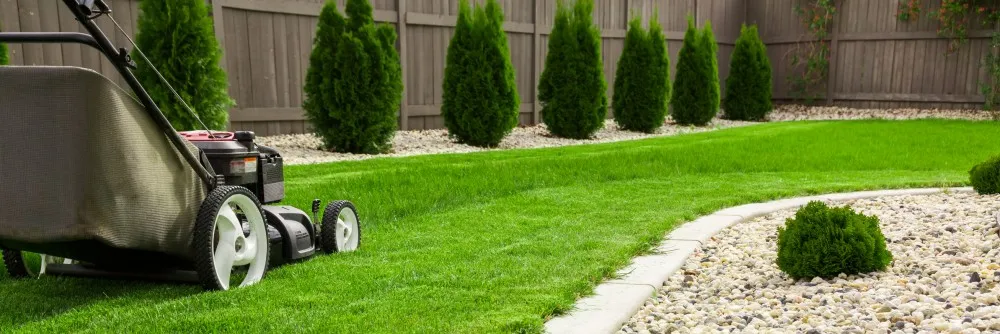You smother your grass with love—mowing it, watering it, treating it for pests, and babying it through dry spells. But like any loving parent, your attentiveness could be overdoing it. The harsh truth: Some people damage their lawn by doing the wrong things.
To keep your front Gainesville yard thriving, make sure you steer clear of these common lawn care mistakes. Before long, your friends and neighbors are sure to ask, "How on Earth does your lawn look so great?" Because that's one of the goals, right?
Mistake #1: Cutting grass too short
Who doesn’t like a manicured lawn? But if you cut your grass too short, the shoots get weak and will be unable to produce strong roots. Weak grass won’t stand up to heat and is more easily overwhelmed by crabgrass and other weeds.
The correct height for grass depends on its species. St. Augustine grass is our most common for Gainesville yards, and it likes to be mowed no lower than 3.5" - and most commonly it prefers 4-4.5"
The rule of thumb is to cut no more than one-third of the height of the grass at a time. This provides enough greenness to allow grass to photosynthesize and produce enough energy to survive the cut. This typically means cutting once per week in the growing season.
For Zoysia, Centipede, Bermuda, and Bahia (less common turfgrasses for North Florida lawns) we recommend about 1-2" lower than St. Augustine calls for.
Change the cutting height of your mower by using the adjustable levers at each wheel. It takes a few minutes, but it’s worth the time and will make a big difference in your lawn with deeper roots and more drought tolerance.
Also, make sure the mower blades are sharp to produce a clean cut that helps grass recover quickly. Dull blades tear the grass and make it more susceptible to disease.Sharpen blades with a metal file at least twice a year, or use a sharpening service that typically charges a small fee, usually around $10.
Mistake #2: Not Watering Enough
You might think you’re doing your lawn right because you're following the 2 days per week rule per the Alachua County Irrigation Code. However, it isn't necessarily about how often you water as much as it is how much water is going onto the lawn when you do run your sprinkler system.
We blankly recommend about 45-75 minutes for rotor zones and 15-25 minutes for spray zones (on turf). This can be adjusted up and down for unseen considerations like sandy or clay soil, shade or sun, and type of grass. The major thing to consider is also how long the grass has been installed. If it's a new lawn, it will need much more water - and the code allows for exceptions with freshly planted sod and plantings to get them rooted in.
Mistake #3: Overtreating Lawns with fertilizer, weeds, and pest control
A well-fed lawn is a happy lawn, right? Well, if a little is good then a lot is better, right? An overabundance of nitrogen—a main nutrient supplied by most lawn fertilizers—causes excessive leaf growth and limited root growth, resulting in weak grass that’s susceptible to disease and drought stress. Also, heavy doses of fertilizer will “burn” roots, causing them to shrivel. Overtreating for weed control can do the same thing.
It’s best to use a slow-release fertilizer applied 3 times per year—in the spring when grass is growing rapidly, second in the early summer to increase density, and again in the fall to strengthen your turf roots for winter. Never fertilize in the heat of midsummer, or you’ll greatly increase the chance of problems.
Overtreatments with products bought at the big box hardware stores is a call we get about 15-20 times per year. Hiring a trusted and quality Gainesville lawn fertilization service is cheaper than re-sodding your lawn.
Mistake #4: Planting the wrong species
You might love the cool, lacy feel of Zoysiagrass, but it won't grow well in deep shade. You may love prefer the thick blades of St. Augustine grass, but it won't thrive in dry areas of your lawn (lack of irrigation and direct sunlight) without extra care and water.
Most yards are a mix of sun and shade, so when planting a new lawn use IFAS's website for proper turf types.
Mistake #5: Loving your pets more than your lawn
I love pets and so should you. However, you need to be aware that some types of pets and lawns are opposed. Pets like to go to the bathroom on the lawn and prefer to use the same path for their running routine. This is an undeniable fact of life. While it's better that they do their business outside the house instead of on your hardwood floor, the ammonia, salts, and high levels of nitrogen in pet urine fry grass and cause ugly brown spots on the lawn. If you start early, you can train your puppy to go in a special spot of the yard with gravel that doesn't mind a little piddle. But if your pooch pees on grass—and you catch him in the act—you should try to quickly water the area to dilute it.
Their running pattern also will wear spots in your lawn from traffic stress. This is a little harder to curb with some dogs, but changing habits can be achieved. My solution for my home is that my 2 pups own the backyard, and my beautiful part of my lawn is in the front.


